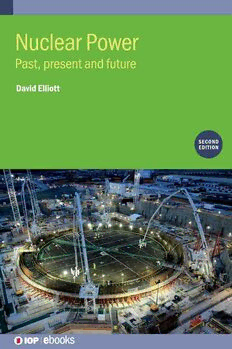
Nuclear Power: Past, present and future PDF
Preview Nuclear Power: Past, present and future
Nuclear Power (Second Edition) Past, present and future Nuclear Power (Second Edition) Past, present and future David Elliott Open University, UK IOP Publishing, Bristol, UK ªIOPPublishingLtd2022 Allrightsreserved.Nopartofthispublicationmaybereproduced,storedinaretrievalsystem ortransmittedinanyformorbyanymeans,electronic,mechanical,photocopying,recording orotherwise,withoutthepriorpermissionofthepublisher,orasexpresslypermittedbylawor undertermsagreedwiththeappropriaterightsorganization.Multiplecopyingispermittedin accordancewiththetermsoflicencesissuedbytheCopyrightLicensingAgency,theCopyright ClearanceCentreandotherreproductionrightsorganizations. PermissiontomakeuseofIOPPublishingcontentotherthanassetoutabovemaybesought [email protected]. DavidElliotthasassertedhisrighttobeidentifiedastheauthorofthisworkinaccordancewith sections77and78oftheCopyright,DesignsandPatentsAct1988. ISBN 978-0-7503-5152-2(ebook) ISBN 978-0-7503-5150-8(print) ISBN 978-0-7503-5153-9(myPrint) ISBN 978-0-7503-5151-5(mobi) DOI 10.1088/978-0-7503-5152-2 Version:20220501 IOPebooks BritishLibraryCataloguing-in-PublicationData:Acataloguerecordforthisbookisavailable fromtheBritishLibrary. PublishedbyIOPPublishing,whollyownedbyTheInstituteofPhysics,London IOPPublishing,TempleCircus,TempleWay,Bristol,BS16HG,UK USOffice:IOPPublishing,Inc.,190NorthIndependenceMallWest,Suite601,Philadelphia, PA19106,USA Coverimage:CourtesyofEDF(UK) Contents Author biography vii Bias viii Figure Acknowledgements ix Personal Acknowledgements x 1 Introduction: the nuclear vision 1-1 1.1 Nuclear energy: uranium in a bucket 1-1 1.2 Atoms for peace 1-3 1.3 The rise and fall of nuclear power 1-7 1.4 On to generation IV? 1-10 References 1-12 2 Nuclear innovation: the early days 2-1 2.1 Early US experiments 2-1 2.2 Thorium reactors and fast breeders 2-3 2.3 What next? 2-7 2.4 Design parameters, choices, and constraints 2-9 References 2-13 3 New brooms–in the 2000s 3-1 3.1 Back to breeders—and thorium 3-2 3.2 Small is beautiful—SMRs 3-8 3.3 Reactor choices and prospects 3-14 References 3-18 4 Progress in the 2020s 4-1 4.1 SMRs move ahead tentatively 4-2 4.2 ANT—a wider range 4-7 4.3 Fusion expectations 4-10 4.4 The prospects for advanced nuclear power 4-14 References 4-15 v NuclearPower(SecondEdition) 5 Nuclear power revisited 5-1 5.1 A review of the prospects for new nuclear technologies 5-2 5.2 Carbon intensity, materials, and land use 5-6 5.3 Nuclear and renewables 5-10 5.4 What long-term future for nuclear power? 5-13 References 5-20 6 Conclusions: the way ahead 6-1 6.1 The issues ahead 6-1 6.2 Choices ahead 6-5 6.3 An end to nuclear? 6-8 6.3.1 Afterword: insider views 6-11 References 6-13 Appendix 1: Public opposition to nuclear power 7-1 Appendix 2: Nuclear and renewables—the basics compared 8-1 Further reading, contacts, and videos 9-1 vi Author biography David Elliott David Elliott worked initially with the UK Atomic Energy Authority at Harwell and the Central Electricity Generating Board before moving to The Open University, where he is now an Emeritus Professor. During his time at The Open University he created several courses in design and innovation, with special emphasis on how the innovation development process can be directed towards sustainable technologies. He has published numerous books, reports, and papers, especially in the area of developing sustainable and renewable energy technologies and systems. vii Bias Thenuclearpowerfieldiscontentious,withstrongpro-andanti-nuclearviewsoften being expressed. This study strives to avoid polarised extremes, but perhaps inevitably, since it adopts a critical approach, it may be seen as biased by nuclear enthusiasts. However, it may also be seen as not critical enough by those strongly opposed to nuclear power. Guide to technical terms and units Some major reactor types ANT Advanced nuclear technology BWR Boiling water reactor EPR European pressurised-water reactor Heavy water has a different isotope of hydrogen HTGR High-temperature gas-cooled reactor IFR Integral fast reactor LFTR Liquid fluoride thorium reactor Light Water is the normal stuff! LWR Light water reactor MSR Molten salt reactor PWR Pressurised water reactor SMR Small modular reactor A quick guide to key atoms… Some can be made to fission (split) and so are said to be ‘fissile’. U235 A rare fissile isotope of uranium. U238 What most uranium consists of: it is ‘fertile’, i.e. it can be converted to: Pu 239 Plutonium, a fissile material, made from U238 by absorbing a neutron Th232 Thorium is not fissile, but is fertile, i.e. it can be converted to: U233 A fissile product of thorium, made from Th232 by absorbing a neutron Neutrons are electrically neutral particles that exist (along with protons) in the nucleusofmostatomsandwhichcanbeemittedwhentheatomsdisintegrate,e.g.as a result of fission. Energy units Reactor power generation capacities are cited in Megawatts (MW) or Gigawatts (GW)—1 GW is 1000 MW. 1 MW is 1000 kilowatts (kW). A typical one-bar electric fire power rating is 1 kW. Running it for an hour would use 1 kilowatt-hour (kWh) of energy. A 1 MW-rated wind turbine, if it could be run flat out, would generate 1000 kWh, or 1 MWh; a 1 GW nuclear plant would generate 1000 MWh, or 1 GWh, but energy outputs are usually quoted in annual terms. In what follows, to make this book accessible to the non-specialist reader, and for brevity, the physics has been kept to a minimum and much simplified (some might say too much). viii Figure Acknowledgements 1.1 A 1950’s UK miss: Harwell researchers and the ZETA fusion reactor. Credit: United Kingdom Atomic Energy Authority. 2.1 The four Generations of nuclear plant types. Credit: From the GIF 2014 report published by the OECD, available free from the GIF portal http://www..gen-4.org/. 2.2 Energy R&D funding in the IEA countries. Credit:IEA,2007https://www.iea.org/reports/reviewing-rd-policies.Allrightsreserved. 2.3 Renewables accelerate ahead of all else, including nuclear. Credit: From the World Nuclear Industry Status Review, 2021, reproduced with permission, data from the BP Statistical Review, 2012. 5.1 Levelized cost of electricity based on Lazard data. Credit: Reproduced from Our World in Data - Max Roser, from https://commons. wikimedia.org/wiki/File:3-Learning-curves-for-electricity-prices.png. CC-BY 4.0. 5.2 UK Nuclear Industry Association expansion plan 2020. Credit: Courtesy of the Nuclear Industry Association—www.niauk.org. 5.3 UK National Nuclear Labs expansion plan. Credit: NNL 2021. 6.1 Completion delays for various energy investment project options. Credit: National Infrastructure Commission (2021), letter to the Chancellor of the Exchequer: advice on nuclear power plant deployment, based on data from Sovacool B, Gilbert A, and Nugent D (2014) ‘An international comparative assessment of construction cost overruns for electricity infrastructure’, Energy Research & Social Science 3 152–60. ix
